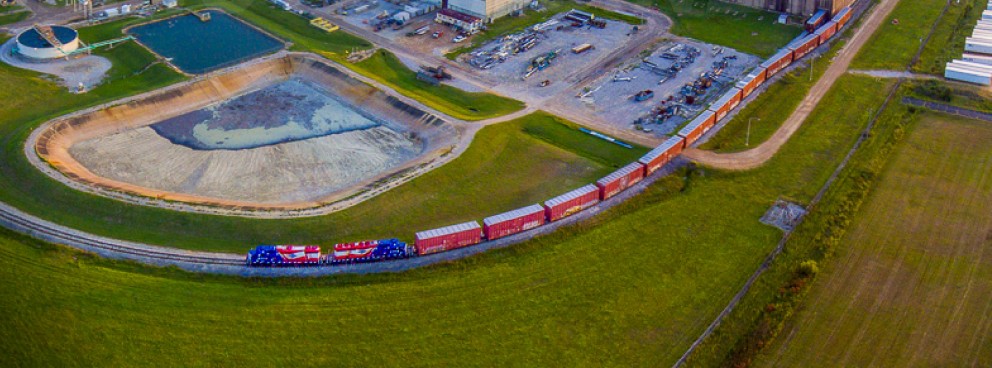Back on track: Rescued from oblivion, Grenada Railroad delivers vital opportunity.
04/05/2021

The history-rich Grenada Railroad has long been known for one dramatic rescue: On an April night in 1900, it was on its tracks that rail engineer Casey Jones became a legend for his heroism saving the lives of his passengers when his train speeded toward a deadly collision outside Vaughn, Mississippi.
Now another dramatic save is making news—the rescue of the historic rail line itself, brought back from the precipice of extinction. And news is doubly good, since those tracks where Casey Jones made history and where the fabled City of New Orleans train once ran are now creating unprecedented economic opportunity for the Central Mississippi region.
In 2011, the 80 miles of track between Grenada and Canton had been closed and seemed destined to vanish in a rails-to-trails conversion. But that disappearance didn’t happen, and instead of grass growing between the tracks, today prosperity is flourishing alongside the rail line, as industrial carloads roll on the revitalized Grenada Railroad, stretching 188 miles from Memphis, TN to Canton, MS. And according to a study commissioned by the Mississippi Development Authority and the Mississippi Department of Transportation, Grenada Railroad now supports a total of 11,174 jobs, $1.3 billion in gross product and $1 billion in personal income.
When the work in progress on the northern 100-mile project is completed in 2021 the entire 188 miles of the Memphis, TN to Canton, MS line will be rated at 286,000 gross weight on rails (GWR) with an authorized speed of 40 MPH making it a Class III Short Line Railroad.
“This final upgrade is a real victory,” says Mr. Larry Hart, President of the North Central Mississippi Regional Railroad Authority (NCMRRA). “It’s a victory for the railroad, for Mississippi industry and economic development, and for all the people the railroad supports. But it’s also a big victory for showing how determination can bring great ideas to fruition. People were ready to give up on this line.”
A foregone collision or a lack of vision?
According to Mr. Hart, the near demise of the rail line was not a simple story of old-fashioned rail colliding with modern transportation economics. Instead, the cause of the neglect was simply a lack of vision, of how 21st century rail could prosper while helping area industry thrive.
And it was that vision that prompted the formation of the NCMRRA with representation from seven Central Mississippi counties, including Grenada County. NCMRRA purchased the line with a two-part $43 million loan to the Authority from the State of Mississippi. The NCMRRA then entered into a Lease-Purchase Operational Agreement with RailUSA, headquartered in Boca Raton, FL and who will oversee day-to-day operations.
NCMRRA was awarded a $7.5 million Federal Grant to rehabilitate the southern portion of the line from Grenada, MS to Canton, MS with RailUSA providing a $7.5 million match for a total rehab project of $15 million dollars.
More recently RailUSA was awarded a $6.2 million Federal Grant to rehabilitate the northern portion of the line from Grenada, MS to Memphis, TN. RailUSA will provide the match of $6.2 million making a total project of $12.4 million dollars.
Barbara Wilson, RailUSA President and CFO, notes, “As a short line railroad, Grenada Railroad provides critical support to area industry because of the rail line’s exceptional connectivity, linking to five Class I lines at the Memphis Gateway, including CN, CSX, BNSF, UP and NS.”
Grenada Railroad delivers good news for Resolute Forest Products.
For operations like the Grenada plant of Resolute Forest Products, that level of reach and connection are key to fast, economical product movement. The Resolute plant’s annual output—229,000 metric tons of high-quality newsprint—is ultimately sold to publishers in the Southeastern United States as well as Mexico and Latin America. Those publishers, squeezed ever more tightly by digital disruption, are eyeing margins, and Grenada Railroad helps Resolute maintain fast shipping that keeps costs low.
Also, as Resolute moves forward with its award-winning initiative to reduce energy and emissions, Grenada Railroad is a good fit in sustainability. Shipping freight by rail emits three times less nitrogen oxide and particulates per ton-mile than highway transit.
“The Grenada mill makes a sheet of newsprint revered for printability in Mexico,” explains Dan Hogan, General Manager of Resolute Forest Products, Grenada Mill. “The Grenada railroad provides a way to economically ship newsprint to the Mexico and Latin American market and has been instrumental to the mill’s continued success and viability. Other US newsprint consumers are also now accessible by rail.”
Today, eight industrial parks along the Grenada line, from Montgomery County, Mississippi to Memphis, directly connect approximately 2,500 acres of certified sites to the rail line, with more than 4,000 acres of developable land in proximity. With the Grenada-to- Canton track opening for industrial shipment, those numbers are sure to grow, and thanks to the speed upgrade, handling those loads is assured.
“Now, with economical rail shipping, existing sites and acreage, and a robust talent pipeline, this region is able to offer extraordinary opportunity for global industry,” notes Matthew Harrison, Chief Executive Officer of Greater Grenada Partnership, the region’s economic development organization. “I think we’ll see transformational results.”
In the popular folk song “The City of New Orleans,” lyrics refer to “the disappearing railroad blues.” But for Grenada Railroad that disappearance didn’t happen because of a forward-thinking partnership of public and private effort, a rescue that has business and industry, workers and their families, singing the praises of the dramatically revitalized result.

